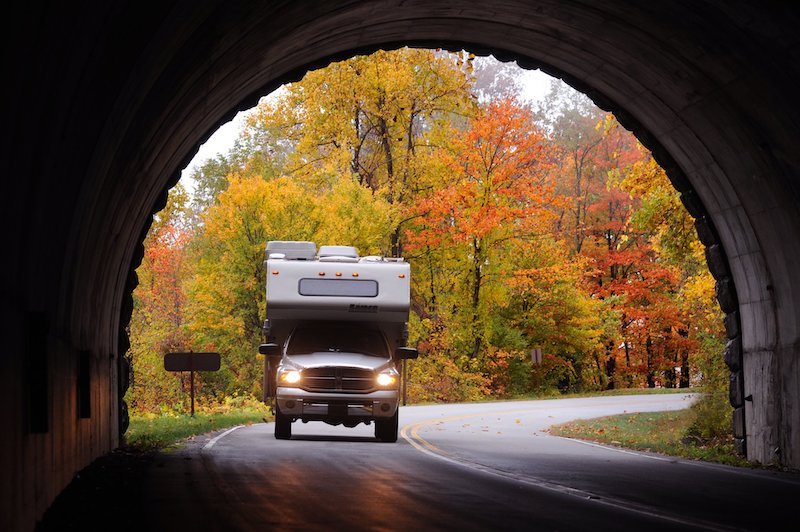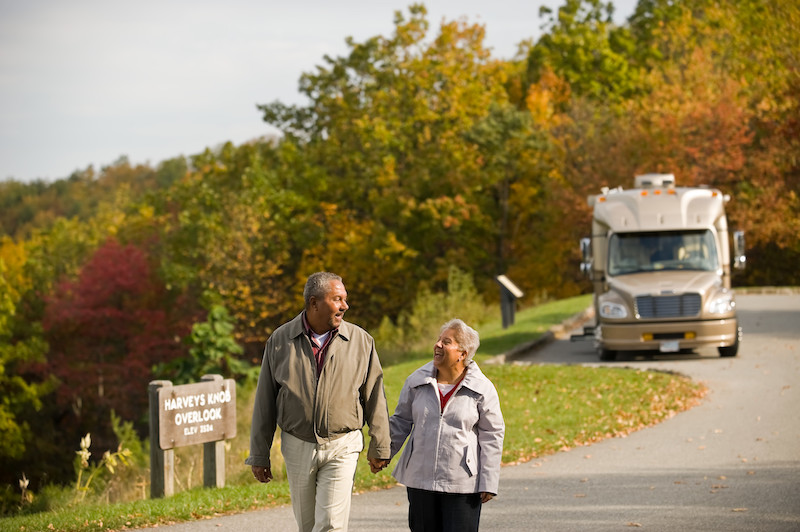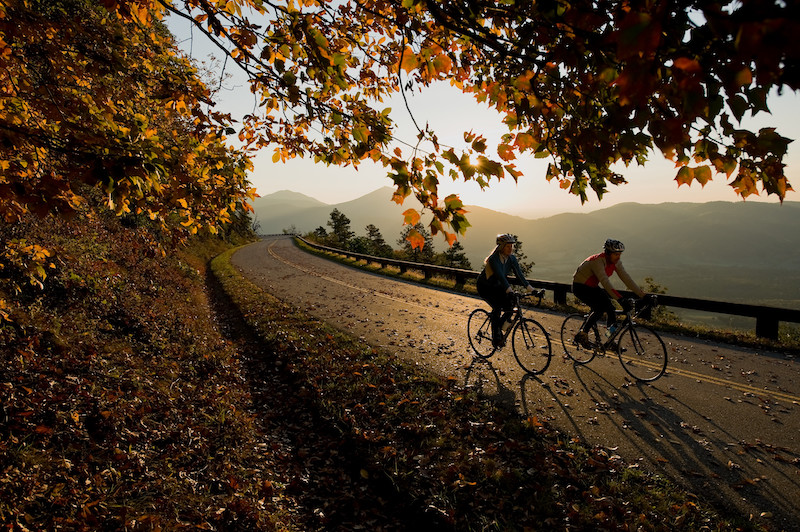CONSIDERED AMERICA’S Favorite Drive in one of the most scenic areas of the United States, the Blue Ridge Parkway, which rambles 469 miles through the Blue Ridge Mountains from North Carolina to Virginia, demands a slower pace and offers breathtaking views.
Hopping on and off the parkway is always an option, but many choose RVs to discover the entire stretch at one time, providing unique experiences, making their own schedules and choosing inspiring elements of discovery.

First and foremost, no matter the mode of transportation or when you go, make sure the parkway is open. Between November and March, nature calls the shots since much of the parkway is located at high elevations. A real-time closure page is available through the National Park Service; no matter the season of travel, take a look before you head out and daily. Observe posted speed limits; its slow design is on purpose and the leave no trace rule applies.
Next, download the mile-by-mile Blue Ridge Parkway Travel Planner. Downloadable maps are available for a small fee that will allow you access regardless of whether cell service is available. This invaluable resource will guide you through each region with suggested itineraries and seasonal events as well as services available. A PDF booklet is available to print.
Traveling in an RV means you must know its height. There are 26 tunnels on the parkway, most in North Carolina. The average height at the edge line is approximately 13 feet.
Keep in mind that the parkway is marked by milepost markers. The 0-milepost marker is at Rockfish Gap in Virginia, with 469, the southernmost point, in Cherokee, North Carolina.

Planning overnight stops should be first on the timeline. Camping sites fill up quickly, so plan to book months, if not a year, in advance. There are eight campgrounds on the parkway open from May through late October. Since they were built years ago, they do not offer RV hookups (water and electricity); however, restrooms, picnic tables and grills are available. Camping is permitted in these sites only on a first-come, first-served basis at $20 per night. Keep in mind there are many privately owned campgrounds within a few miles of the parkway and most are open year-round. Contact them directly for reservations. Visit www.recreation.gov for a full list of campgrounds and what each can accommodate.
Once reservations are made for overnight and length of stays are determined, there are some locations—documented from south to north—that you do not want to miss.
The Parkway Visitor Center in Asheville (milepost 384) is the perfect place to start. Not only will it provide the latest information on the parkway, but exhibits will put the road in context. Before hitting the road, get started with French Toast or a Manmosa (PBR + OJ) at Louise’s Kitchen (milepost 383), a turn-of-the-century establishment serving creative foods with Southern flair.
As you drive through the Pisgah National Forest, keep in mind that hiking trails are abundant. If you’re pulling in here for the night, you’ll spend the night in the parkway’s highest campground. There’s also a dining option at Pisgah Inn, one of the few on the parkway.

If traveling in early summer, Craggy Gardens (milepost 364) shows off when the rhododendrons explode with color, and in the late summer, berries are plentiful. Hike the 1.9 (round trip) miles to the summit and enjoy one of the most beautiful views along the route.
Mount Mitchell (milepost 355) rises 6,684 feet above the Appalachians. On a clear day, the view is 85 miles. Oddly, vehicles can drive “almost” to the peak without a too strenuous hike.
Three-tiered Linville Falls (milepost 316.4) on Grandfather Mountain (milepost 308-304) descends nearly 2,000 feet into the gorge, considered the Grand Canyon of the Southern Appalachians. One of the most popular waterfalls in North Carolina, the fall trail is relatively easy but the trail to the gorge is strenuous.
Pay attention to the Linn Cove Viaduct (milepost 304), the last section of the parkway to be completed. Get your heart racing with a walk on the Mile High Swinging Pedestrian Bridge with sweeping views of Grandfather Mountain.
Hungry for more? Make a stop at Old Hampton Store and Barbeque (milepost 308) for a step back in time at a country store serving mouth-watering BBQ.
A favorite of visitors is Doughton Park (milepost 238.5) where Appalachian history lives in the meadows and mountainsides. Get in step with folk music at the Blue Ridge Music Center (milepost 213). Open Thursday through Monday through October, stop and explore the roots of Blue Grass and enjoy the free Midday Mountain Music performances by local musicians.

One of the most photographed locations is Rocky Knob and Mabry Mill (milepost 167-176). Appalachian life continues to put context to this historic mill. A stop at Harvey’s Knob (milepost 95) provides a view of the Great Valley of Virginia and the fall migration of butterflies.
Peaks of Otter (milepost 85) is one of those premier destinations that have drawn visitors for decades. From hiking trails to a campground, it’s the ideal spot to conclude the Blue Ridge Parkway adventure reflecting by the shores of Abbot Lake. Although no RVs are allowed at the Ravens Roost Overlook (milepost 10.7) parking area, this provides picturesque views of the Shenandoah Valley.
Other stops worth making are Natural Bridge, Virginia (milepost 61, KOA campground); Bedford, Virginia, and the National D-Day Memorial; Thomas Jefferson’s Poplar Forest, his personal retreat; Mt. Airy, North Carolina (milepost 199); and Cherokee, North Carolina (milepost 469).
While this is simply a meager list of opportunities available along this majestic parkway, a traveler’s adventure can be as plentiful as time allows. With rentals of RVs at an all-time high, now is the time to plan this unique adventure for 2022, making campground reservations and planning excursions. Enjoy the ride, and most of all, enjoy the pauses along the route that will make lifetime memories.
BEST IN CAMPING
In addition to the eight campgrounds within the National Park System, others are available within a short drive. Reservations (all campgrounds) are encouraged to be made in advance online at Recreation.gov. Find the full list on the website; here are a few of the popular options. Prices begin at $20 per night, and reservations should be made months in advance. Check the app for gas availability.
MOUNT PISGAH CAMPGROUND
(milepost 408.8) 124 miles off the parkway near Canton, North Carolina
LINVILLE FALLS CAMPGROUND
(milepost 316.4) 63 miles from the parkway near Newland, North Carolina
JULIAN PRICE CAMPGROUND
(milepost 297.0) 47 miles off the parkway near Boone, North Carolina
ROCKY KNOB CAMPGROUND
(milepost 167.1) 44 miles off the parkway near Floyd, Virginia
PEAKS OF OTTER CAMPGROUND
(milepost 85.9) 101 miles off the parkway near Bedford, Virginia
OTTER CREEK CAMPGROUND
(milepost 60.8) 118 miles off the parkway near Monroe, Virginia
